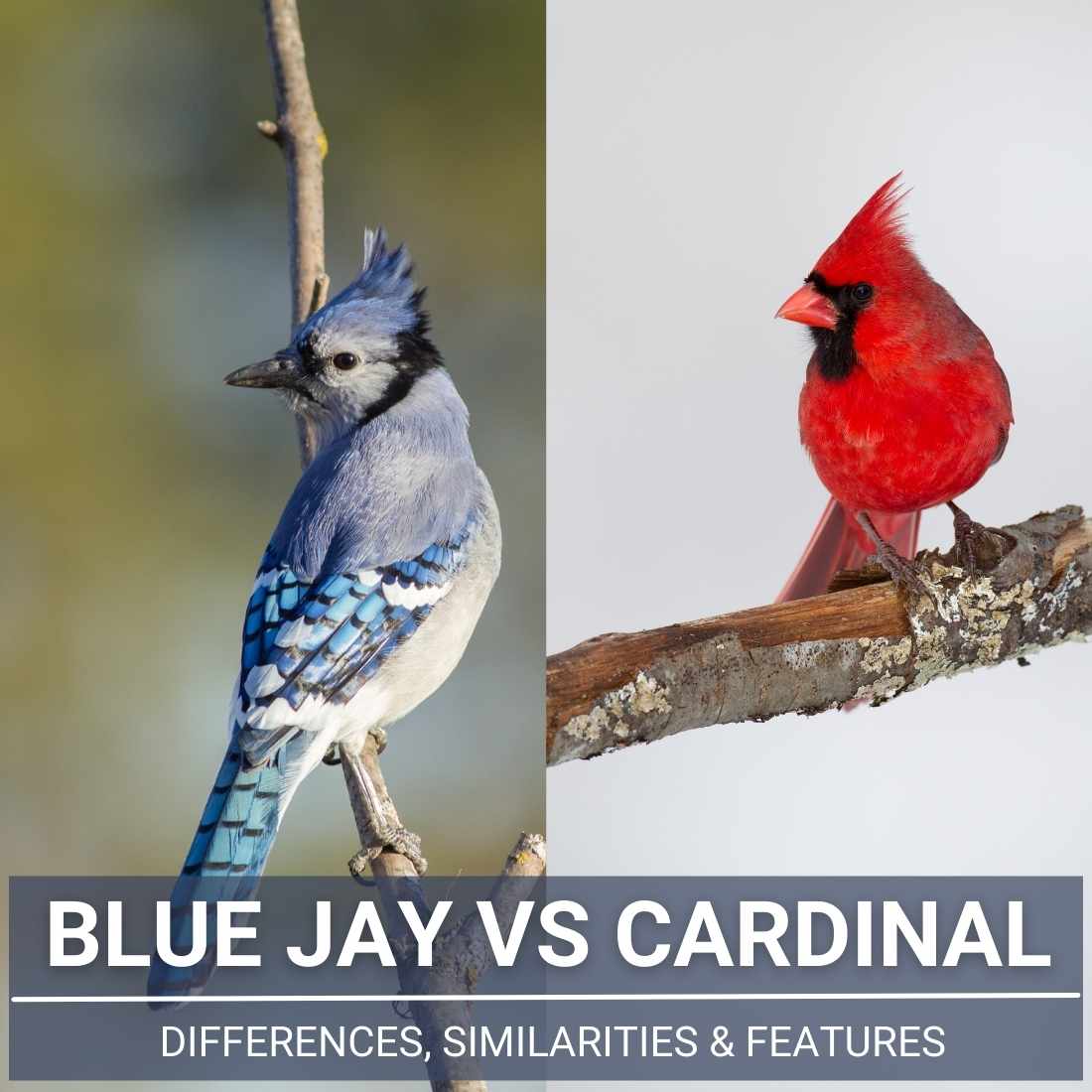Blue Jay VS Cardinal: two vibrant avians, each a spectacle of nature, but how do they compare?
Despite their shared elegance and North American habitats, Blue Jays and Cardinals are distant relatives with unique characteristics. They are intriguingly similar yet strikingly different, not just in color but in behavior and diet as well.
In this article, we’ll delve into these fascinating aspects, offering you a captivating exploration that uncovers the mysteries of these two beloved birds. Stay with us to discover more.
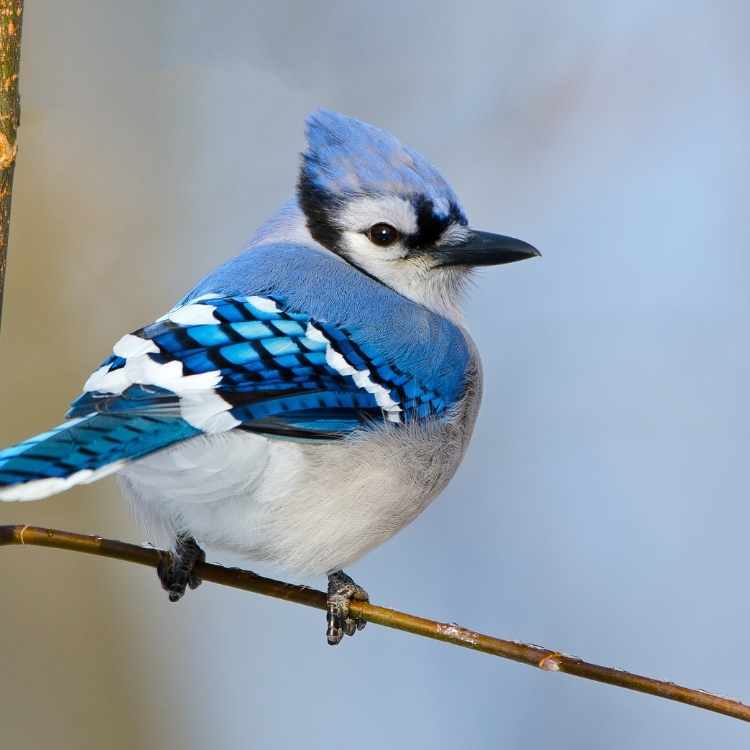
Table of Contents
- 1 Overview of Blue Jays vs Cardinals
- 2 Table: Overview of Blue Jay vs Cardinal
- 3 Coloration and Patterns
- 4 Comparing Behavioral Traits
- 4.1 Origin
- 4.2 Habitat Preferences
- 4.3 Nesting Habits
- 4.4 Mating Behavior: A Tale of Two Courtships
- 4.5 Eggs: The Beginning of New Life
- 4.6 Migration: Seasonal Journeys
- 4.7 Vocalizations: A Symphony of Differences
- 4.8 Song Duration: The Long and Short of It
- 4.9 Cardinal’s Song: A Unique Melody
- 4.10 Territorial or Aggressive Behaviour: Dominance in the Sky
- 5 Feeding Habits Comparison: A Culinary Dichotomy in the Avian World
- 6 Attracting Blue Jays and Cardinals: A Bird Lover’s Guide
- 7 Blue Jay vs Cardinal: Differences in Symbolism
- 8 Top 10 interesting facts about the Cardinal
- 9 Top 10 interesting facts about the Blue Jay
- 10 Final Verdict
- 11 FAQs
Overview of Blue Jays vs Cardinals
Blue Jays and Cardinals are two captivating bird species that grace North American backyards.
Blue Jays, flaunting their striking plumage, belong to the Corvidae family, known for their intelligence. On the other hand, Cardinals, recognizable by their vibrant red color, are members of the Cardinalidae family.
Both species are classified as passerines, or perching birds, though they are not closely related. Despite their different lineages, they share intriguing similarities. Both are admired for their bright colors, distinctive calls, and fondness for seeds, adding a delightful spectacle for birdwatchers and nature enthusiasts alike.
The interesting thing about Cardinals and Blue Jays is that besides having huge differences between them, they both belong to the same bird order, known as ‘Passeriformes.’
Table: Overview of Blue Jay vs Cardinal
| Cardinal | Blue Jay | |
|---|---|---|
| Song Duration and Type | Cardinals make a melodious whistling song that typically lasts for 2-3 seconds. | Blue Jays produce whispering tones that intriguingly last for around 2 minutes. |
| Bill Shape | Cardinals sport a short and thick bill, ideal for cracking open seeds. | Blue Jays have a long and straight bill, versatile for a varied diet. |
| Flight Speed | Cardinals display a flight speed of about 17-18 miles per hour. | Blue Jays can fly at speeds of 20-25 miles per hour. |
| Lifespan | The average lifespan of a Cardinal is between 7-8 years. | Blue Jays typically live longer, with an average lifespan of 13-15 years. |
| Egg Incubation Period | Cardinals incubate their eggs for 11-13 days. | Blue Jays incubate their eggs a bit longer, generally for around 18 days. |
| Number of Eggs | Cardinals typically lay 2-4 eggs per clutch. | Blue Jays are known to lay more eggs, usually around 3-7 per clutch. |
| Size | Cardinals are slightly smaller than Blue Jays, with body sizes typically ranging from 7-9 inches. | Blue Jays are larger, generally measuring between 9-12 inches in length. |
| Family/Origin | Cardinals belong to the Cardinalidae family. | Blue Jays are members of the Corvidae family, which includes crows and ravens. |
| Coloration | Cardinals boast mostly red plumage, with some brown and white markings. | Blue Jays are known for their vibrant blue plumage, complemented with white and black markings. |
| Wingspan | Cardinals have a wingspan that ranges from 9-12 inches. | Blue Jays possess a larger wingspan, measuring between 13-17 inches. |
| Facial Appearance | Cardinals have a distinctive black ‘mask’ on their face. | Blue Jays have a white faces with black necklace-like markings around the throat. |
| Gender Identification | In Cardinals, males are vibrant red, while females are brown. | In Blue Jays, there’s little sexual dimorphism, with both sexes appearing similar. |
| Habitat | Cardinals can be found in woodlands, gardens, and swamps. | Blue Jays prefer forests, parks, and residential areas. |
| Mating Behaviour | Cardinals are monogamous and typically mate for life. | Blue Jays are also monogamous, and many pairs mate for life. |
| Nesting | In Cardinals, both sexes participate in building the nest. | In Blue Jays, the female is primarily responsible for nest construction. |
| Migration | Cardinals are partially migratory, with some populations moving south for winter. | Blue Jays are also partially migratory, with northern populations moving south during winter. |
| Physical Appearance of the Juvenile Stage | Juvenile Cardinals appear similar to adult females, but their plumage is duller. | Juvenile Blue Jays resemble adults, but their plumage is less vibrant and more mottled. |
| Feed | Cardinals primarily feed on seeds, grains, insects, and fruit. | Blue Jays have a varied diet including seeds, grains, insects, and small vertebrates. |
| Aggressiveness | Cardinals are generally calm but can be defensive during the breeding season. | Blue Jays are known for their assertiveness and can be quite |
| Where can they be found | Prevalent across the Northeast, Midwest, and South, but generally absent in the West. | Widely distributed across the Northeast, Midwest, and South, with limited presence in the West. |
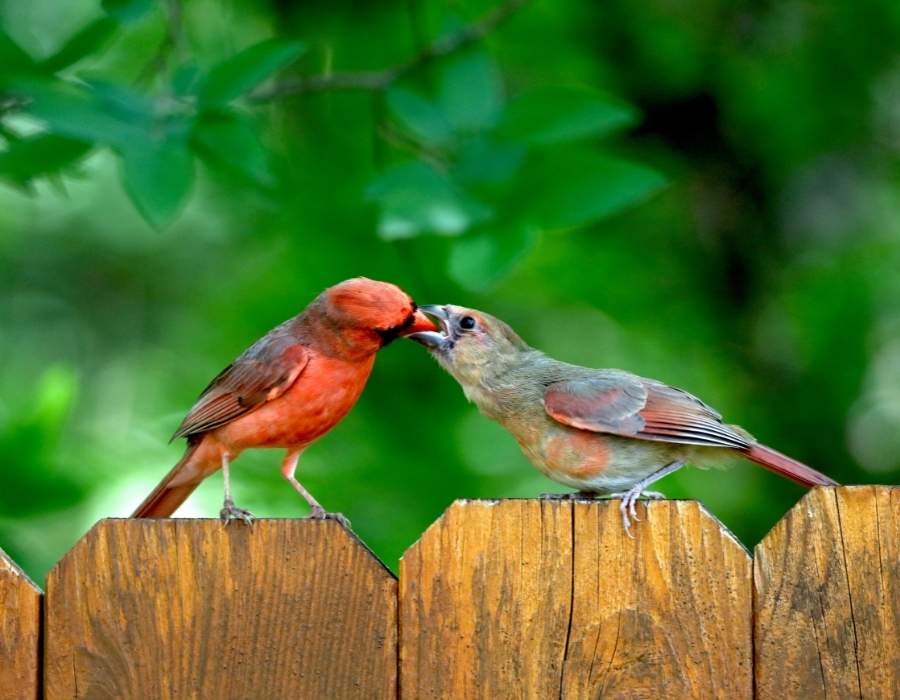
Coloration and Patterns
Cardinals and Blue Jays both have lovely patterns and coloration on their bodies that complement each other, but the red color is predominant in the Cardinal compared to Blue Jay, which has a dominating blue color (as its name suggests). The blue jay has a blackish-blue and a whitish belly, whereas the Cardinal has a red back with a whitish belly.
The blue jay has blue, white, and black patterns on its wings and tail. When the wings expand, you can see the inside of the wing is coated with white. This is one of the most distinguishing characteristics of these birds. The back, wings, and body of the Cardinal have a dark red and brown coloration.
Distinctive Features: Crest and Black Markings
Both birds have a prominent crest that may be lowered at their relaxation. Although both have a little black on them, the distinction resides in where the black is concentrated.
The blue jay has a prominent black ring around its neck, which gives the appearance of a necklace. The Cardinal has a black band around its beak that gives the impression that it is wearing a mask.
Size and Anatomy: An Overview
Aside from the differences in coloration, patterns, and markings, the two species have a few other distinguishing characteristics. So continue reading.
While the average length of the two birds is around the same, ranging between 20-25cm, their bulk is significantly different. A blue jay typically weighs between 65 and 110 grams, but a cardinal weighs around 43 grams on average.
Beak Characteristics: A Closer Look
Both birds have a powerful bills, but when you look at them carefully, you can see that they are anatomically different. The Cardinal’s beak is small and thick, while the blue jay has a bill that is straight and a little long.
Gender Identification: Subtle Signs in the Spectrum of Colors
In Cardinals, males boast a vibrant red, while females don a subtle brown. Blue Jays, however, exhibit no gender-based color differences.
Juvenile Stage: The Dawn of Colors
Juvenile Cardinals and Blue Jays initially sport muted colors, gradually acquiring their distinctive red and blue hues as they mature.

Comparing Behavioral Traits
Origin
Contrary to popular belief, not only are the Blue Jay and the Cardinal members of separate genera, but they are also members of distinct families, as well.
In scientific terms, cardinals are members of the Cardinalidae family, which is comprised of members of the cardinal order. The blue jay is a member of the Corvidae family of birds, which is formally known as the crow family.
Habitat Preferences
Blue Jays exhibit a certain degree of adaptability when it comes to their habitats. They can be found in a variety of environments, but they demonstrate a particular affinity for oak trees, where they are most frequently sighted.
Their preference leans towards the edges of forests, where the woodland meets open land, rather than the dense, secluded depths of the forest.
Cardinals may be found in various habitats, including woodland edges, grassy lawns, trees and shrubs, back gardens, and well-landscaped areas.
Nesting Habits
Blue Jays, primarily inhabiting forest edges, choose to establish their nests in both deciduous and coniferous tree species, often at considerable heights.
In contrast, Cardinals, renowned for their adaptability, prefer nesting in dense shrubbery, providing them with ample cover and safety.
Mating Behavior: A Tale of Two Courtships
Cardinals exhibit monogamous relationships, while Blue Jays display complex, communal courtship rituals.
Eggs: The Beginning of New Life
Cardinal females lay 2-4 eggs, while Blue Jays can lay between 3-7 eggs, all meticulously incubated.
Migration: Seasonal Journeys
While Cardinals stay put year-round, Blue Jays showcase partial migration, with some populations moving south during winter.
Vocalizations: A Symphony of Differences
Even though both birds are classified as songbirds, their vocalizations are quite different. The blue jay has a mellower voice and almost sounds like a whisper compared to other birds. In contrast, the Cardinal’s song sounds just like someone is whistling if you listen closely.
Song Duration: The Long and Short of It
Singing over a longer amount of time is characteristic of the blue jay, with a single song lasting as long as 2 minutes. In contrast, the song of a cardinal is brief, lasting just approximately 2-3 seconds on average.
Cardinal’s Song: A Unique Melody
Cardinal’s song comprises a long succession of clear two-parted whistles that are periodically accelerated before culminating with a progressive treble at the end.
In conclusion, while both bird species share the songbird classification, their singing behavior presents fascinating contrasts, offering a unique auditory experience to bird enthusiasts.
Territorial or Aggressive Behaviour: Dominance in the Sky
Territorial or aggressive behavior is prevalent in both Blue Jays and Cardinals, especially during the breeding season. Blue Jays are known for their aggressive nature, often defending their territory and young vigorously. They might even mimic the calls of hawks to scare off intruders.
Cardinals, on the other hand, exhibit shyness yet also display protective behavior during breeding periods. Male Cardinals are particularly territorial and can even engage in combat with their reflection, mistaking it for an intruder. Despite these aggressive tendencies, it’s important to note that both species display a complex array of behaviors that depend on the specific context and environmental factors.
Feeding Habits Comparison: A Culinary Dichotomy in the Avian World
The Omnivorous Diet of Blue Jays: A Mixed Bag of Surprises
Blue Jays, being omnivorous, exhibit a wide-ranging palate. While they have a pronounced preference for insects, fruits, and grains, their diet also includes more unconventional fare for a bird, such as frogs and mice. A particularly intriguing aspect of their feeding habits is their predilection for eggs of other bird species, a behavior that’s relatively unusual in the avian world.
Cardinals: The Seed and Fruit Aficionados
On the contrary, Cardinals are granivorous, opting primarily for a diet of grains, seeds, and fruits. Their food preferences are largely plant-based, making them an integral part of the ecosystem by aiding in seed dispersal.
The Overlapping Dietary Preferences: A Point of Convergence
Despite these differences, there are intriguing commonalities in their diet as well. Both species exhibit a preference for certain types of seeds and fruits, implying some overlap in their feeding habits despite the significant divergence. This shared gastronomic trait further illustrates the complex and fascinating dynamics of bird behavior and ecology.

Attracting Blue Jays and Cardinals: A Bird Lover’s Guide
Creating a bird-friendly environment can invite these beautiful creatures into your backyard. For Blue Jays, provide feeders with peanuts, sunflower seeds, or suet, as these are among their favorite foods. Consider adding a bird bath as well, since they’re known to enjoy water.
Cardinals, on the other hand, are attracted to sunflower seeds and safflower seeds. They prefer feeders with large perches or flat platforms due to their size. Providing dense shrubbery or thickets in your garden can also provide the cover they prefer for nesting.
Both species appreciate a reliable source of clean water for drinking and bathing, so maintaining a bird bath can help attract both. Remember, it’s important to keep your feeding stations clean and free from predators to maintain a safe and welcoming environment for all your feathered guests.
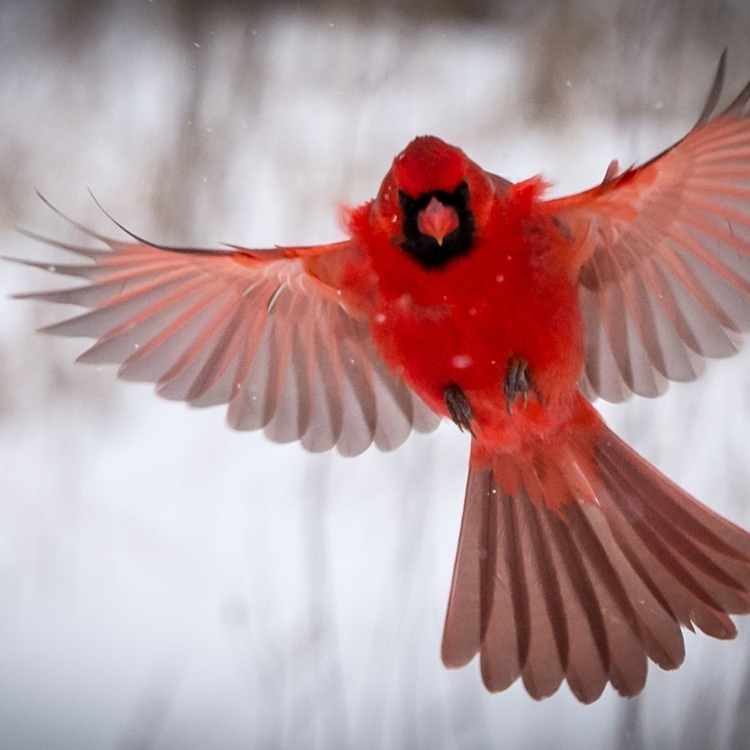
Blue Jay vs Cardinal: Differences in Symbolism
The Blue Jay and Cardinal hold distinct symbolism in various cultures and beliefs.
Blue Jay Symbolism: Spiritual Wisdom and Guidance
In some religious beliefs, the Blue Jay holds spiritual significance as a symbol of wisdom and guidance. Its ability to mimic other sounds is seen as a metaphor for listening and discerning divine messages.
The Blue Jay’s blue feathers are associated with heavenly realms and spiritual enlightenment, reflecting the importance of seeking knowledge and spiritual growth.
Cardinal Symbolism: Divine Presence and Protection
The Cardinal also carries religious connotations in certain faiths, representing divine presence and protection. Its vibrant red plumage is often associated with the blood of Christ, signifying sacrifice and redemption. The Cardinal’s presence is considered a reminder of faith, hope, and the assurance of divine love and protection.
These religious connotations deepen the symbolic significance of the Blue Jay and Cardinal, connecting them to spiritual realms and emphasizing their roles as messengers and symbols of spiritual wisdom and divine presence.
Top 10 interesting facts about the Cardinal
- Xanthochroism: In some cases, cardinals may appear yellow due to a genetic abnormality known as xanthochroism, which alters their conventional red color.
- Vocal Virtuosity: Cardinals can sing more than 24 different songs, showcasing their impressive vocal range and musical abilities.
- Year-round Residents: Cardinals do not migrate, making them year-round residents in the eastern part of the United States, providing constant vibrant color to local landscapes.
- Varied Habitats: You can find cardinals in diverse environments, from backyards and parks to forests, marshes, and even deserts, as long as there is dense low cover.
- Duet Singing: One of the few bird species where both sexes sing, Cardinal pairs often exchange song phrases, especially during the nesting season. This unique call-and-response can be seen as a form of communication.
- Distinctive Appearance: With their bright red color, crested heads, and robust beaks, Cardinals are easily identifiable and beloved by bird watchers.
- Long Lifespan: Cardinals can live up to 15 years in the wild, making them one of the longest-living songbirds.
- Diet: Cardinals primarily eat seeds, grains, and fruits, but they will also consume insects, especially during the breeding season.
- Pair Bonding: Cardinals are monogamous, and pairs will stay together throughout the year, often seen feeding each other as a sign of affection.
- State Bird: The Cardinal is so loved that it is the state bird for seven US states: Illinois, Indiana, Kentucky, North Carolina, Ohio, Virginia, and West Virginia.
We have more content about the cardinal on our site: Cardinal Symbolism, The Red Cardinal: Biblical Symbolism And Spiritual Meaning, and the Cardinal feather meaning.
Here you can check all Cardinal sounds
Top 10 interesting facts about the Blue Jay
- Sound Mimicry: Blue Jays can mimic a variety of sounds, even imitating hawks, specifically the Red-shouldered Hawk, to deceive predators in their habitat.
- Sexual Monomorphism: Unlike many bird species, male and female Blue Jays look identical, an attribute called sexual monomorphism, making gender identification a bit tricky.
- Flock Mentality: Blue Jays are known for their strong flock mentality. They travel and cooperate together, often chasing away other birds from “their” feeders when threatened.
- Origin of the Name: The term “blue Jay” was given due to their loud and lively nature. They were seen as impertinent birds who dominated conversations in their surroundings.
- Varied Diet: As omnivores, Blue Jays have a varied diet which includes insects, grains, and even small rodents. They have also been observed eating the eggs of other birds.
- Distinctive Appearance: With their striking blue, white, and black plumage, and the prominent crest on their heads, Blue Jays are easily identifiable and a delight to bird watchers.
- Intelligent Birds: Blue Jays are considered intelligent birds with complex social systems and tight family bonds. They are known to use tools for tasks like extracting food.
- Migration Mystery: Unlike many bird species, not all Blue Jays migrate during winter. The reason behind this selective migration is still a mystery to ornithologists.
- Communicative Calls: Blue Jays have a vast repertoire of calls. Each call may vary in volume, pitch, rhythm, and quality, indicating different messages.
- Longevity: Blue Jays have relatively long lifespans, often living up to 13-15 years in the wild if they can avoid predation and disease.
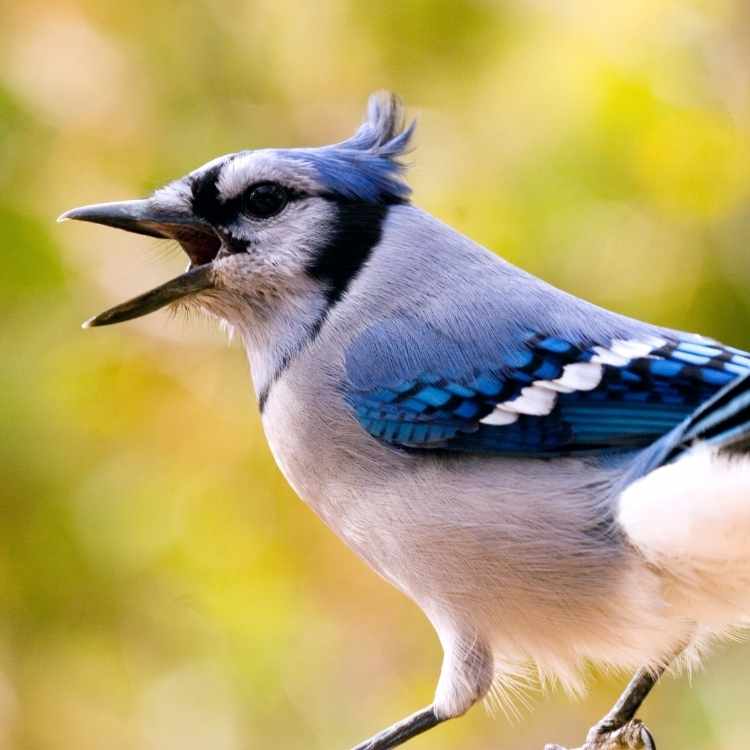
Other interesting facts about blue jays include:
We wrote some more posts about the beautiful blue jay: Blue Jay Feather Symbolism, Blue Jay: Symbolism and Meaning, Seeing a Blue Jay – what Does It Mean? (Biblical Meaning and Symbolism), Top 5 Blue Jay Feeders, Birds That Are Blue – The Top 12 Most Beautiful Ones.
Here you can check all Blue Jay sounds
Final Verdict
In the end, whether you find yourself on Team Blue Jay or Team Cardinal, there’s no denying the charm and allure of these feathered rivals.
From their vibrant colors to their melodic songs, these birds have carved their place in the avian kingdom. So, next time you spot a flash of blue or a burst of red, take a moment to appreciate the beauty and unique traits of these fascinating creatures.
And remember, in the eternal debate of Blue Jay Vs Cardinal, there’s room for both to soar and enchant us with their captivating presence.
We also compared the Bluebird Vs Blue Jay as well as Red Robin Vs Cardinal – in case you’re interested.
FAQs
What is the difference between a cardinal and a blue jay?
Cardinals and Blue Jays significantly differ in their color, family origins, dietary habits, and songs. Cardinals, primarily recognized for their vibrant red plumage, belong to the Cardinalidae family and primarily feed on grains, seeds, and fruits, qualifying them as granivorous.
On the other hand, Blue Jays, distinguished by their blue, white, and black markings, are part of the Corvidae family. They have an omnivorous diet, consuming almost anything from cereals to small animals and bird eggs.
Will a blue jay mate with a cardinal?
No, Blue Jays and Cardinals will not mate with each other. These two are separate species with distinct mating rituals, behaviors, and preferences.
Each bird species typically prefers to mate with individuals of its own kind. Interbreeding between these two species is not known to occur in nature.
Is a cardinal a red blue jay?
No, a Cardinal is not a red version of a Blue Jay. Despite the similarities in their vibrant colors, Cardinals and Blue Jays are distinct species. They belong to different families, with Cardinals being part of the Cardinalidae family and Blue Jays hailing from the Corvidae family. Their behaviors, diets, and habitats also vary significantly.
How rare is it to see a blue cardinal?
The occurrence of a blue Cardinal is extremely rare. Cardinals are typically known for their brilliant red coloration. However, in rare instances due to a genetic condition called melanism, they can appear blue. This phenomenon is indeed unusual and is not commonly observed in nature.
Are Blue Jays aggressive?
Blue Jays are indeed known to exhibit aggressive behavior, particularly in the context of defending their territories and nests. They have been observed chasing away larger birds from their habitats. Interestingly, they also mimic the calls of hawks to deter potential threats. Despite their size, they are assertive and quite fearless when it comes to protecting their space.
No, Blue Jays and Cardinals are not closely related. Blue Jays belong to the Corvidae family, while Cardinals belong to the Cardinalidae family. Despite their similar appearances in terms of coloration, they are distant relatives and belong to different bird families.
Do Blue Jays and Cardinals get along?
Blue Jays and Cardinals have a complex relationship. While they may occasionally interact and coexist peacefully, conflicts can arise, especially during territorial disputes. Blue Jays are known for their assertiveness and may chase away other birds, including Cardinals, from their territories.
